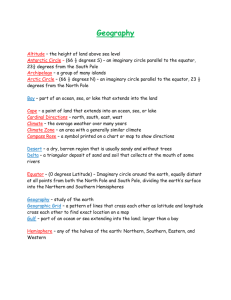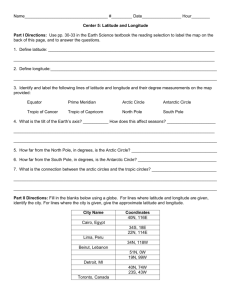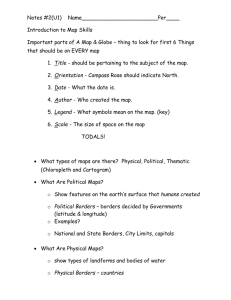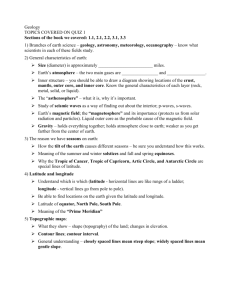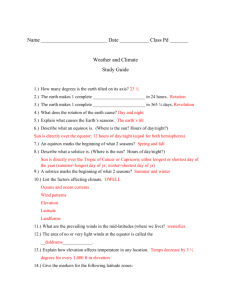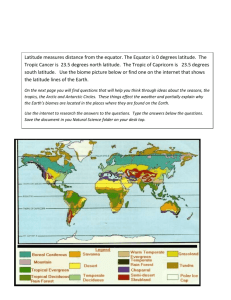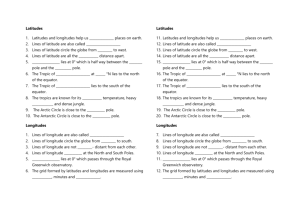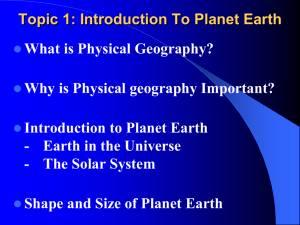File
advertisement
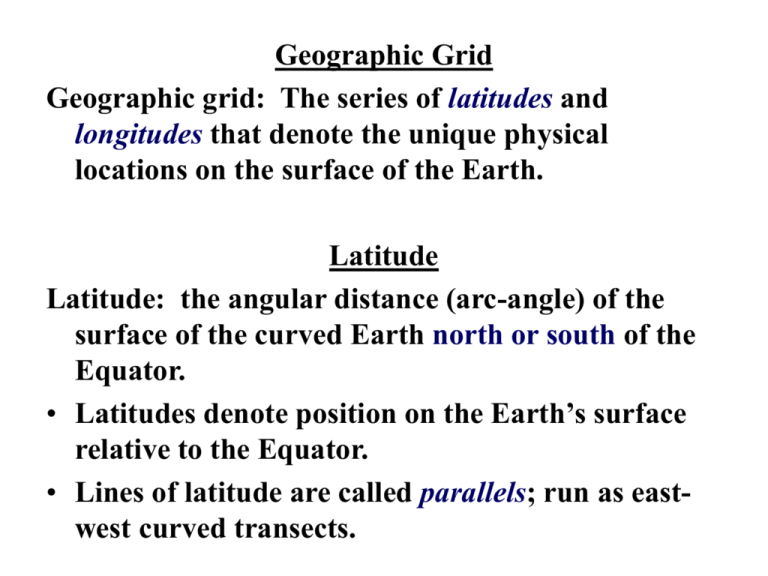
Geographic Grid Geographic grid: The series of latitudes and longitudes that denote the unique physical locations on the surface of the Earth. Latitude Latitude: the angular distance (arc-angle) of the surface of the curved Earth north or south of the Equator. • Latitudes denote position on the Earth’s surface relative to the Equator. • Lines of latitude are called parallels; run as eastwest curved transects. Equator: 0º latitude • Serves as the reference position for all latitudes (positions N and S). • The imaginary great circle that lies equidistance from the north and south geographic poles. • Bisects the Earth into the Northern and Southern Hemispheres. North Pole: 90º N N Arctic Circle: 66.5º N Tropic of Cancer: 23.5º N Equator: 0º Tropic of Capricorn: 23.5º S Antarctic Circle: 66.5º S South Pole: 90º S S Notable Latitudes Equator = 0º North Geographic Pole = 90º N (+ 90º) South Geographic Pole = 90º S (- 90º) Tropic of Cancer = 23º30’ N (+ 23.5º) Tropic of Capricorn = 23º30’ S (- 23.5º) Arctic Circle = 66º30’ N (+ 66.5º) Antarctic Circle = 66º30’ S (- 66.5º) Geographic Poles: The points on the Earth at which the Earth’s imaginary axis of rotation emerges. Earth’s rotation is from West to East; counterclockwise from NP perspective Longitude Longitude: the angular distance (arc-angle) of the surface of the curved Earth east or west of the Prime Meridian. • Longitude denotes position on the Earth’s surface relative to the Prime Meridian. • Lines of longitude are called meridians; run as north-south curved transects • All lines of longitude pass through the N and S poles Notable Longitudes Prime Meridian (Greenwich meridian) = 0º International Date Line = 180º Prime Meridian 0º Meridians Latitude and Longitude Earth’s Rotation The Earth rotates on its axis every 24 hours— completes one day-night cycle. The Earth rotates on its axis from West to East (clockwise from N pole perspective) • The Sun rises at the eastern horizon, crosses the sky, and sets at the western horizon. Technically, the Earth rotates under the Sun allowing for different parts of the Earth’s surface to be illuminated (day) by the Sun and shadowed (night) facing away from the Sun. The Sun appears to move or traverse across the sky (from our reference point), however, it is the Earth doing the moving. Day-night sun cycle • • • • • • • • • Dawn Sunrise Morning Solar noon Zenith Afternoon Sunset Dusk (twilight) Night Every 15º that the Earth rotates corresponds to approximately 1 hour time difference between corresponding position of the Sun in the sky. Time Zones • Time zones are global divisions of time based on sequences of hour divisions. • The Earth completes one rotation every 24 hours. • Therefore, the Earth rotates 15º of longitude per hour. 360 15 hr 24 hr Time zones are first divided into ~ 15º longitude intervals centered at multiples of 7.5º, then adjusted for international political boundaries (small countries) or internal political boundaries (larger countries). The Continental United States (lower 48 states) has four time zones. • Eastern Time • Central Time • Mountain Time • Pacific Time Time Zones The Continental United States (lower 48 states) has four time zones. • Eastern Time • Central Time • Mountain Time • Pacific Time Georgia lies at the westernmost edge of the Eastern Time Zone. Alabama lies at the easternmost edge of the Central Time Zone. Time Zones Remember, the Earth rotates from west to east. Eastern Time Zone is 5 hours behind the Mean Greenwich Time (London) 1 hour earlier than Central Time (e.g., Chicago) 2 hours earlier than Mountain Time (e.g., Salt Lake City) 3 hours earlier than Pacific Time (e.g., Los Angeles) If it is 3 pm in Georgia, = 8 pm London, = 2 pm Chicago, = 1 pm Salt Lake City, = 12 pm Los Angeles. The Sun is the center of our solar system. Heliocentric model. All planets and small bodies orbit the sun (revolve) clockwise as seen from the “top down” view. The Earth rotates 1 time per 24 hours (observed day-night cycle) Earth revolves around the sun 1 time per 365.24 calendar days (observed year cycle) The moon revolves around the Earth 1 time every 27.8 days. The Earth’s orbit lies in the plane of the ecliptic. Plane of the ecliptic--the imaginary plane that extends outward from the equator of the sun. Earth’s orbit is an ellipse, not a perfect circle. The Earth is sometimes closer to the sun and sometimes farther from the sun. Average distance: 150,000,000 km Perihelion 1.477x108 km ~ Jan 3 Aphelion 1.521x108 km ~ July 4 The Earth has axial tilt (obliquity). The Earth is tilted by 23.5º from upright relative to the plane of the ecliptic Zero Axial Tilt No obliquity 23.5º Axial Tilt = 23.5º The line through the Earth is the Equator The Earth has constant axial parallelism or polarity regardless of it’s position around the sun. The North Pole and the South Pole point in the same direction. Notice that different parts of the Earth’s surface receive different amounts of sunlight over the course of the calendar year. This is called seasonality. Vernal equinox Winter solstice Summer solstice Autumnal equinox Where is the Overhead Sun? Mar 21 June 21 Sept 22 Dec 22 Vernal equinox Summer solstice Autumnal equinox Winter solstice Equator Tropic of Cancer Equator Tropic of Capricorn During the equinoxes (equal day) • Overhead sun over the equator • All places on earth have 12 hours of light and 12 hours of dark During summer solstice • Overhead sun over the Tropic of Cancer • All latitudes inside the Arctic circle = 24 hours light • All latitudes inside the Antarctic circle = 24 hours darkness During winter solstice • Overhead sun over the Tropic of Capricorn • All latitudes inside the Antarctic circle = 24 hours light • All latitudes inside the Arctic circle = 24 hours darkness The declination = latitude of the subsolar point. The sun’s altitude above the horizon is based on latitude of the observer relative to the subsolar point. Diagram showing the distribution of incoming solar radiation during the Summer and Winter Solstices.

